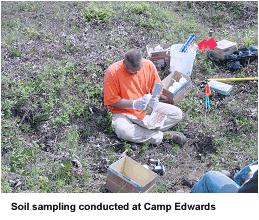 | |||
 | |||
 | |||
 | |||

Gun and Mortar Firing PositionsArtillery and mortars were fired at Camp Edwards since 1911, although more formalized and frequent training began around 1940. The Massachusetts National Guard discontinued the firing of high explosives artillery rounds in 1989 to accommodate citizens’ concerns regarding noise levels heard in neighboring towns. Low intensity training or inert artillery rounds were fired until April of 1997. 37 Gun and Mortar positions are located on the Camp Edwards training ranges and encircle the 2,200 acre Impact Area. These positions were used for training with practice and high explosive artillery and mortar rounds. Propellant bags, a potential source of soil contamination, were possibly burned or buried at some positions. Initial investigations at these positions included historic record reviews, witness interviews and magnetometer surveys. The Remedial Investigation included 691 soil samples and sampling of 18 new and existing monitoring wells. 2,4 and 2,6 DNT, metals, pesticides, SVOCs, and perchlorate were found at elevated levels in soil at some of these sites. 2,4-DNT is the primary contaminant present at the firing positions. It was detected in soil at 15 sites at levels up to 12 parts per million, however, it has not been detected in groundwater at any of the positions. Additional monitoring wells are being installed to complete the investigation. The source of this 2,4-DNT contamination is most likely the result of former practices of burning excess propellant on the ground surface at a position after a firing event. Interview information indicates that whole unburned propellant bags might also have been buried at some of the positions. Two soil Rapid Response Actions have been completed, removing and disposing of approximately 300 cubic yards of soil from Gun Position #7 off-site in 2002 and removing and treating 510 cubic yards of soil from Gun Position #6 by Low Temperature Thermal Desorption in 2005. The Former A Range, Former K Range and Gun and Mortar Positions Decision Document Fact Sheet is available. This document describes the investigations and response actions conducted to date at each of these sites, and the proposed decisions for each. Click here to access it. To obtain more information about this topic, click here. |
|
|
SVOCs are hydrocarbons that partially vaporize when exposed to air
Perchlorate is a contaminant that can exist in the environment as part of other compounds also containing ammonium, potassium or sodium; approximately 90% of the perchlorate produced by US manufacturers has been for use as a rocket fuel oxidizer, and most of the remaining 10% is utilized in military and civilian explosives, munitions, and pyrotechnics (which includes items such as flares and smoke grenades)